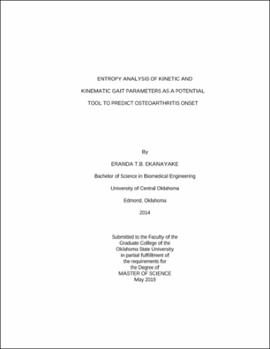| dc.contributor.advisor | Hausselle, Jerome | |
| dc.contributor.author | Ekanayake, Eranda T. B. | |
| dc.date.accessioned | 2021-04-06T16:02:47Z | |
| dc.date.available | 2021-04-06T16:02:47Z | |
| dc.date.issued | 2019-05 | |
| dc.identifier.uri | https://hdl.handle.net/11244/329093 | |
| dc.description.abstract | Osteoarthritis (OA) is a debilitating joint degenerative disease that is expected to drastically increase in prevalence by 2050. Therefore, it is necessary to find innovative ways to predict OA onset with the hopes of implementing preventative measures early on. | |
| dc.description.abstract | OA incidence is positively correlated with increasing age and the female gender. Furthermore, gait analysis has been used to elucidate the biomechanical differences that arise from OA onset. Modern gait analysis research has moved towards non-linear analysis due to the understanding of the deterministic properties of human movement. Approximate Entropy (ApEn) and Fuzzy Entropy (FuzzyEn) are both tools that assess signal regularity under the theory of Optimal Movement Variability, and ApEn has been used in a limited capacity to investigate gait imbalance. The goal of this study was to investigate the efficacy of ApEn and FuzzyEn in assessing differences in gait imbalance parameters between males and females of a fixed age, and females of younger and older age groups, under the context of OA onset factors. | |
| dc.description.abstract | Healthy young males (n=20) and females (n=20) between the ages of 18-25 were analyzed in the first study, while younger females of age 18-25 (n=8) and older females of age 50-60 (n=8) were analyzed in the second study. Subjects walked barefoot on a force sensitive treadmill surrounded by six motion capture cameras at a self-selected speed. ApEn and FuzzyEn calculations were then performed at varying k values on the signals of the peak ground reaction force during heel strike and toe off, medial-lateral center of pressure displacement and range of motion of the hip, knee and ankle. | |
| dc.description.abstract | Our results confirmed that gait was a chaotic and deterministic process, since all subjects showed high entropy values at an input parameter k value of 0.2. FuzzyEn and ApEn values were within 22% for all parameters at k=0.2, showing agreement. ApEn found more significant differences between groups, however FuzzyEn showed more consistency. Therefore FuzzyEn remains a promising tool in the investigation of OA and as a future OA prediction tool. | |
| dc.format | application/pdf | |
| dc.language | en_US | |
| dc.rights | Copyright is held by the author who has granted the Oklahoma State University Library the non-exclusive right to share this material in its institutional repository. Contact Digital Library Services at lib-dls@okstate.edu or 405-744-9161 for the permission policy on the use, reproduction or distribution of this material. | |
| dc.title | Entropy analysis of kinetic and kinematic gait parameters as a potential tool to predict osteoarthritis onset | |
| dc.contributor.committeeMember | DeFreitas, Jason M. | |
| dc.contributor.committeeMember | Wang, Shudao | |
| dc.contributor.committeeMember | Madihally, Sundarajan V. | |
| osu.filename | Ekanayake_okstate_0664M_16103.pdf | |
| osu.accesstype | Open Access | |
| dc.type.genre | Thesis | |
| dc.type.material | Text | |
| dc.subject.keywords | biomechanics | |
| dc.subject.keywords | entropy | |
| dc.subject.keywords | gait analysis | |
| dc.subject.keywords | osteoarthritis | |
| thesis.degree.discipline | Mechanical and Aerospace Engineering | |
| thesis.degree.grantor | Oklahoma State University | |
